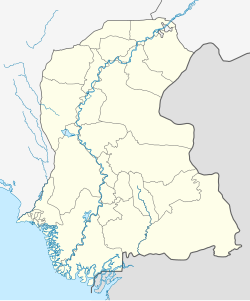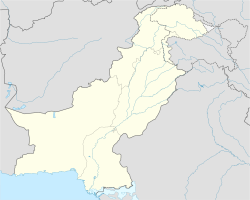Islamkot Tehsil
Islamkot Tehsil
Sindhi: تعلقو اسلام ڪوٽ | |
|---|---|
 | |
| Coordinates: 24°42′0″N 70°11′0″E / 24.70000°N 70.18333°E | |
| Country | |
| Province | Sindh |
| District | Tharparkar District |
| Tehsil | Tehsil |
| Area | |
| 3,515 km2 (1,357 sq mi) | |
| Elevation | 56.48 m (185.3 ft) |
| Population (2023)[2] | |
| 265,643 | |
| • Density | 75.57/km2 (195.7/sq mi) |
| • Urban | 19,064 (7.18%) |
| • Rural | 246,579 (92.82%) |
| Literacy | |
| • Literacy rate |
|
| Time zone | UTC+5 (PST) |
| Main languages | 262,626 Sindhi, 233 Pashto, 158 Hindko[4] |
Islamkot Tehsil[a], also referred to as Islamkot Taluka, is an administrative sub-subdivision (taluka/tehsil) of Tharparkar District, in south-eastern Sindh, Pakistan. Located about 82 kilometres (51 mi) east of the district capital Mithi, and around 360 kilometres (220 mi) east of Karachi, it forms the southern part of the district and borders the Great Rann of Kutch.[b]
According to the 2023 national census, it had a population of 265,643.[2] The majority of residents speak Sindhi. It is one of seven tehsils of Tharparkar, and is connected by both road and air.
Geography
[edit]Islamkot Tehsil, situated at an average elevation of 50 metres (160 ft), covers an area of about 3,515 square kilometres (1,357 sq mi), accounting for roughly 17.9% of Tharparkar District's total area.[2]
It is bounded by Diplo Taluka and Mithi Taluka to the west, Chachro Tehsil to the north, and Nagarparkar Tehsil to the east, while its southern boundary forms part of the international border with India.[5]
Climate
[edit]Islamkot has a hot desert climate (Köppen climate classification).[6] Average temperatures are around 32.5 °C (90.5 °F), rising to 44 °C (111 °F)-48 °C (118 °F) in summer, which is over 11.6% higher than Pakistan's national average.[1] Rainfall is scarce and highly seasonal, with about 15.99 millimetres (0.630 in) falling on roughly 20 days per year, mostly during June to September monsoon, when local rivers briefly flow before drying up again in the long dry season.[1]
Flora
[edit]Its vegetation is typical of the Thar Desert, dominated by xerophytic plants adapted to arid conditions. Common species include shrubs such as Prosopis cineraria (locally known as khejri), Capparis decidua (karir), and Salvadora oleoides (jal).[7] Grasses like Cenchrus biflorus and Lasiurus scindicus dominate the sandy areas and provide seasonal fodder for livestock. Neem trees (Azadirachta indica) are also widely planted to provide shade and greenery in the desert landscape.[7] Vegetation cover increases during the monsoon season, when rainfall supports temporary cultivation and the growth of wild grasses and herbs across the sand dunes and plains.
Fauna
[edit]A 2015 survey of the Thar Desert recorded 35 species of mammals in the talukas of Tharparkar District. Rodents were the most common, followed by Carnivora, along with insectivores, bats, lagomorph, and several hoofed animals.[7]
Population
[edit]The 2023 census recorded 265,643 inhabitants living in 52,507 households.[8] The population density is about 75.5 persons per square kilometre.[2] The literacy rate is 36.01%, with significant gender disparities: 48.29% for males and just 22.97% for females, reflecting limited educational access, particularly for women and girls.[9][3]
Language
[edit]Of the 2023 population of 265,643, Sindhi was spoken by about 98.86% of the residents (262,626 people). Other languages including Pashto (0.09%, 233 people), Hindko (0.06%, 158 people) and various others (0.99%, 2,626 people).[4]
Economy
[edit]The majority of residents depends on subsistence agriculture and livestock rearing, in line with broader patterns in Tharparkar District.[11] About three-quarter of the population are engaged in livestock management and approximately 73% rely on rain-fed farming and animal husbandry.[12] In recent years, development of the Thar Coalfield has introduced wage labour opportunities. More than 35,000 jobs have been created, with about 80% of these positions held by local residents from Sindh.[13]
Infrastructure
[edit]Islamkot Tehsil is linked by metalled roads to nearby towns such as Mithi, Chachro, and Nagarparkar, many of which were historically tree-lined to provide shade. The Mai Bakhtawar International Airport, located 20 kilometres (12 mi) north of Islamkot near the village of Alho Kotrio, was built by the Pakistan Civil Aviation Authority to support access to the Thar coalfield. It was inaugurated in April 2018 and features a 7,000 feet (2,100 m) runway, though regular commercial operations remain limited.[14]
Telecommunication services have expanded significantly, with mobile networks covering most settlements. In 2017, free Wi-Fi services were also introduced in some villages through Public–private partnerships.[15]
Water supply remains a critical challenge due to the arid climate. A large Reverse osmosis plant with a capacity of 1.5 million gallons per day, is being rehabilitated to improve access to clean water, complemented by pipeline upgrades in the region, though challenges persist.[16]
Electricity is mainly provided through the Sindh Engro Coal Mining Company (SECMC) projects linked to the Thar Coalfield, which have extended grid connections to Islamkot and surrounding villages, significantly improving local electrification.[17]
References and notes
[edit]Explanatory notes
[edit]- ^ Sindhi: تعلقو اسلام ڪوٽ, pronounced [taʕˈlu.qu ɪsˈlaːm koːʈ], Urdu: تحصیل اسلام کوٹ, pronounced [tɛhˈsiːl ɪsˈlaːm koːʈ]
- ^ This salt marsh in the Thar Desert forms seasonal wetlands, mainly situated across the international boundary with Kutch district in Gujarat, India.
References
[edit]- ^ a b c "Islamkot, Sindh". weatherandclimate.com. Retrieved 22 August 2025.
- ^ a b c d "Table 1: Area, Population by Sex, Sex Ratio, Population Density, Urban Population, Household Size and Annual Growth Rate, Sindh" (PDF). pbs.gov.pk. Pakistan Bureau of Statistics, Census. 2023. Retrieved 22 August 2025.
- ^ a b "Table 12: Literacy Rate, Enrolment and Out of School Population by Sex and Rural/Urban, Census 2023" (PDF). pbs.gov.pk. Pakistan Bureau of Statistics. Retrieved 22 August 2025.
- ^ a b "Table 11: Population by Mother Tongue, Sex and Rural/Urban, Census 2023" (PDF). pbs.gov.pk. Pakistan Bureau of Statistics. Retrieved 22 August 2025.
- ^ Brinkhoff, Thomas. "Pakistan: Sindh (Districts and Subdistricts) - Population Statistics, Charts and Map". www.citypopulation.de. Retrieved 31 August 2025.
- ^ "Islamkot, Sindh, Pakistan". www.mindat.org. Hudson Institute of Mineralogy. Retrieved 22 August 2025.
- ^ a b c Khan, Abdul Aziz; Khan, Waseem Ahmad; Chaudhry, Aleem Abdul (September 2015). "Mammalian Diversity in Thar Desert Habitat of Tharparkar District, Sindh, Pakistan". Pakistan Journal of Zoology. 47 (5): 1205–1211. Retrieved 22 August 2025.
- ^ "Table 24: Housing Characteristics, Facilities of Toilet and Washroom used by Households, Rural/Urban: Census 2023" (PDF). pbs.gov.pk. Pakistan Bureau of Statistics. 2023. Retrieved 22 August 2025.
- ^ Tunio, Shabana; Ahmed Soomro, Lubna; Khaskhely, Nosheen (July 2015). "An Analysis of the State of Female Education in Sindh and Role of Television in Increasing Literacy Rate". Journal of South Asian Development. 4 (2): 37-42. ISSN 2304-375X. Retrieved 22 August 2025.
- ^ "Table 9: Population by Sex, Religion and Rural/Urban, Census - 2023" (PDF). pbs.gov.pk. Pakistan Bureau of Statistics. 2023. Retrieved 22 August 2025.
- ^ Hassan, Sher Shah; Goheer, Muhammad Arif; Farah, Humera; Nadeem, Momana; Muazzam, Aleeza; Munir, Jahan Ara; Fatima, Saba (1 August 2024). "Monitoring the effects of climate change and topography on vegetation health in Tharparkar, Pakistan". Journal of Water and Climate Change. 15 (8). London: IWA Publishing: 3472–3486. doi:10.2166/wcc.2024.398. Retrieved 22 August 2025.
- ^ Rahimoo, Ali Nawaz (7 March 2014). "Drought in Tharparkar". tribune.com.pk. The Express Tribune. Retrieved 22 August 2025.
- ^ Rasool, Usama Ghulam (20 November 2024). "Empowering Tharparkar through Skills Development". nation.com.pk. The Nation. Retrieved 22 August 2025.
- ^ Subhani, Mushtaq (31 August 2021). "Sindh govt decides to functionalise Islamkot airport". thenews.com.pk. The News International. Retrieved 22 August 2025.
- ^ "Reham inaugurates first free WiFi villages of Tharparkar". brecorder.com. Business Recorder. 14 March 2017. Retrieved 22 August 2025.
- ^ "555 out of 834 govt RO plants in Thar are dysfunctional". tribune.com.pk. The Express Tribune. 21 December 2023. Retrieved 22 August 2025.
- ^ Rizvi, Kazim Raza (1 November 2023). "Village Electrification Project (VEP) inaugurated; 1000+ solar systems will be provided to households in Thar Coal Block II. Amir Iqbal, CEO SECMC". CustomsNews. Retrieved 22 August 2025.

